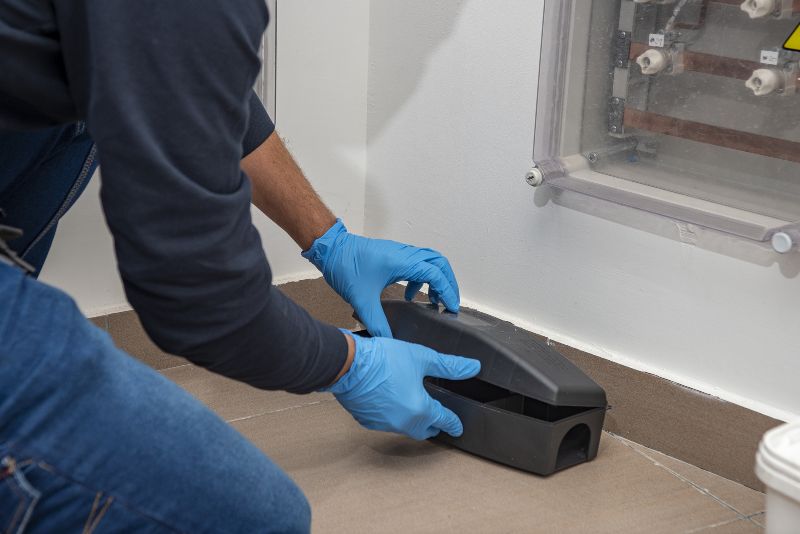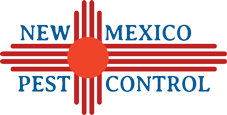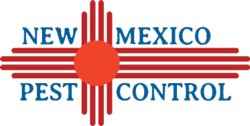Rat & Mice Exterminators – Control – Removal
Serving Albuquerque and Taos
Rodent infestations are notoriously difficult to control and prevent without the help of an expert mouse exterminator. Because they are resilient creatures that can squeeze between even the smallest of openings in your home, it can be a complex process to completely exterminate them. In order to take care of the problem before it becomes more serious, it is important to call professional rat & mice exterminators after the very first sighting of a mouse or rat on your property. By enlisting the expertise of qualified rat exterminators like those at New Mexico Pest Control, you can ensure the rodent infestation will be handled professionally.
Pest Control
You Can Trust.
Serving New Mexico since 1945.

Professional Rodent Exterminators
Even if you’ve taken measures to get rid of rodents yourself, it’s likely that you haven’t eliminated them entirely. Some mice can fit through tiny openings that are hard for a non-professional to spot. Considering the health risks and possible damage rodents can bring with them, it’s essential to get rodent exterminator service in a timely matter. A professional mice exterminator will not only control them, they can make sure they never return.
Common Rodents in Santa Fe and Albuquerque
The following rodents are found in the Santa Fe NM area:
Say Goodbye To Rodents. Get Started Today!

Our Rodent Removal Process
At New Mexico Pest Control, our rat and mouse exterminators go above and beyond in taking all steps necessary to eliminate rodent infestations:
- Conducting a thorough inspection of the property to locate possible access points.
- Placement of non-toxic traps and monitoring stations in discrete locations.
- Sealing of all common entry points suspected of contributing to the infestation.
- Creating a full report for our customers describing the individual treatments and how to protect the home from future infestations.
FREQUENTLY ASKED QUESTIONS ABOUT RODENTS
What is a rodent?
The word rodent originates from the French word rodere, meaning “to gnaw.” Rodents use their powerful incisor teeth as chisel tools to gnaw through insulation, wood, walls and electrical wiring causing extensive damage to homes and structures. Common pest rodents include the house mouse, deer mouse, Norway rat, roof rat and wood rat commonly called a pack rat. Rodents are nocturnal, meaning they are active at night and not during the day.
What do rodents look like and what do they eat?
All rodents are mammals and share a few common characteristics including furry robust bodies, short legs, long tails and a pair of incisor teeth that never stop growing. They use their sharp teeth to gnaw food, excavate burrows and to defend themselves. Most rodents tend to prefer eating plant foods like seeds, grains, and small fruit. However, mice and rats are omnivores, meaning their diet consists of plant and animal products.
What are the most common rodents in homes?
The house mouse, Norway rat, and roof rat are the three most important rodent pests to invade homes. These rodents are commensal, which means “to share the table.” They have been given this name as they live near and benefit from an association with humans, inhabiting homes, gardens, farms, food stores, apartments and commercial buildings.
What are the differences between a mouse and a rat?
The major differences between mice and rats are their size and diet. The typical house mouse is 2-4” in length, as opposed to the Norway rat or roof rat, which can measure up to 9” in length. Both mice and rats are omnivores, but rats will eat anything, and generally prefer meat, pet food, fish, and stored cheeses. Mice prefer grains, fruits, vegetables, seeds, and nuts.
What does a house mouse look like?
Adult house mice range in total size from 5-8” in length, including their tail. Their ears are moderately large and distinct and their bodies can be light brown to nearly black in color, with a belly that is slightly lighter. House mouse tails are hairless and as long as the body and head combined. The average adult weighs up to 1 ounce, although some mice may be heavier.
What does a Norway rat look like?
The Norway rat is relatively large and the average adult measures 16” in total length from its nose to the end of its tail, and weighs about 12 ounces. The length of the tail is shorter than its body and it is typically grayish brown to black or reddish-brown in color. The Norway rat’s tail is darker on top and more pale underneath.
What does a roof rat look like?
Adult roof rats, sometimes called black rats, are medium-sized rats weighing 8 – 12 ounces and measuring about 16” in total length from nose to tip of tail. Although their length is similar to the Norway rat, the roof rat’s tail is longer than the body and a key identifying characteristic. In general, roof rats are sleeker than Norway rats. Adults may be brown to entirely black in color.
Where do mice and rats live?
House mice build nests outdoors in ground burrows, barns and sheds, and will construct nests indoors in attics, wall voids, storage boxes, and under appliances. Norway rats build burrows outside along foundations and gardens or may be found inside homes, in basements and crawl spaces. Roof rats are good climbers and nest in trees, rooflines, block walls, attics, garages, sheds and in ceilings.
How do mice and rats get inside homes?
Mice and rats use their exceptional athletic abilities to gain access to homes. Rodents are excellent climbers and rats can jump from overhanging trees to access roof lines and attics. Mice can squeeze through a hole the size of a dime and rats only need a gap the size of a quarter. Rodents enter homes using gaps around dryer vents, utility pipes, exterior doors, and garage doors, and will also gain entry through chimneys.
Can mice and rats spread disease?
Rodents are known to spread more than 35 diseases, including hantavirus, leptospirosis, lymphocytic choriomeningitis (LCMV), Tularemia and Salmonella. These diseases can be spread to humans directly by handling live or dead rodents, through contact with rodent feces, urine, or saliva, and through rodent bites. Additionally, the droppings and urine of house mice and rats contain allergens that can trigger rhinitis in susceptible individuals.
What damage can mice and rats cause in homes?
Because of their gnawing damage to wires, pipes, gas lines, and the like, rodent infestations hold the potential for serious damage relative to fires and explosions. Accounts of the rodents’ ability to start fires by carrying matches to their hiding places, as well as by causing short circuits through the gnawing of electrical wires have been widely reported. Chewed, exposed wires inside walls may spark, causing interior walls to catch fire.
What are signs of a rodent infestation?
The sighting of live or dead rodents on your property, is a sure sign of rodent activity. Also look for droppings, gnaw marks, gnawed fruit in trees, and scratching sounds at night. Look for gnaw marks on door corners, walls, and baseboards. Rat droppings are shiny black and ½ to ¾” long, and mice droppings are smaller with pointed ends. Spotting burrows outdoors along foundations, walls or trees is a sign of Norway rat activity.
What attracts mice and rats to homes?
Rodents enter homes for three reasons—food, shelter and warmth. Mice and rats are warm-blooded mammals and will nest in attics, wall voids, garages, and crawl spaces. Rodents will eat anything and are especially attracted to food sources like grains, meat, birdseed, pet food, and garbage debris. Leaky faucets and dripping pipes provide rodents the water needed for survival. Compost piles and pet waste debris in yards are another food source and very attractive to rodents.
How do you get rid of rodents in the home?
The three steps homeowners can take to help eliminate a rodent infestation are inspection, sanitation, and exclusion. First, inspect your property for signs of rodents and then eliminate entry points by rodent-proofing your home. Snap traps, live traps, and glue boards can be an easy and inexpensive way to get rid of rodents. However, if the rodent infestation is large, a pest management professional may be required to eliminate the infestation for good.
How can you prevent a rodent infestation?
Eliminating access to your home and removing any food or water resources will help to deter a rodent infestation. Seal gaps and holes around utility cables, outdoor vents or pipework with steel wool or silicone-based caulk. Remove clutter, keep a clean home, and use tight-fitting lids on trash bins. Outdoors, pick up fallen fruit, clean up around bird feeders or use a “no-waste bird food”, remove leaf litter and pick up pet waste.

Professional Rat & Mice Exterminators
If you’ve experienced a rodent sighting in your home or the prevention techniques you’ve tried aren’t working, it’s time to call your local rat & mice exterminators. At New Mexico Pest Control, we pride ourselves on our professional and knowledgeable team of exterminators who will work with you to remove rodent infestations and keep them from returning. Call us today for a free quote and say goodbye to rodents in your home for good!
Pest Control You Can Trust
At New Mexico Pest Control, we protect against the disease and damage that can be caused by common pests.

